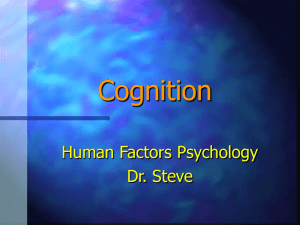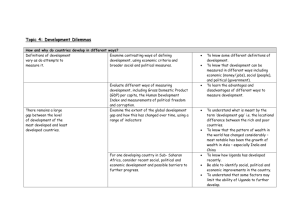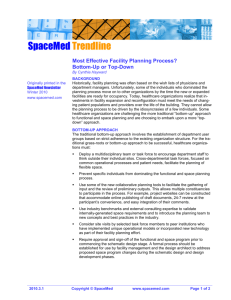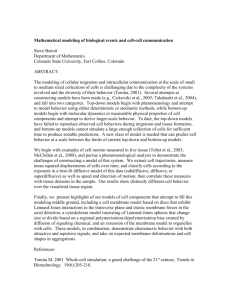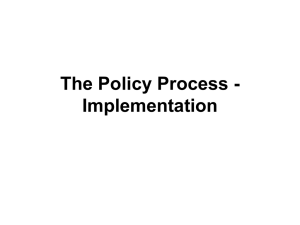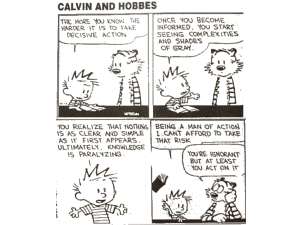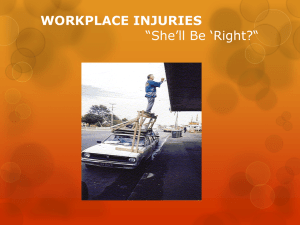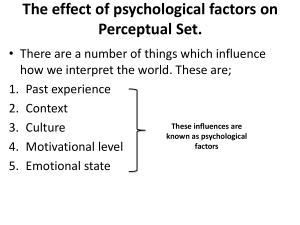Cognition Notes
advertisement
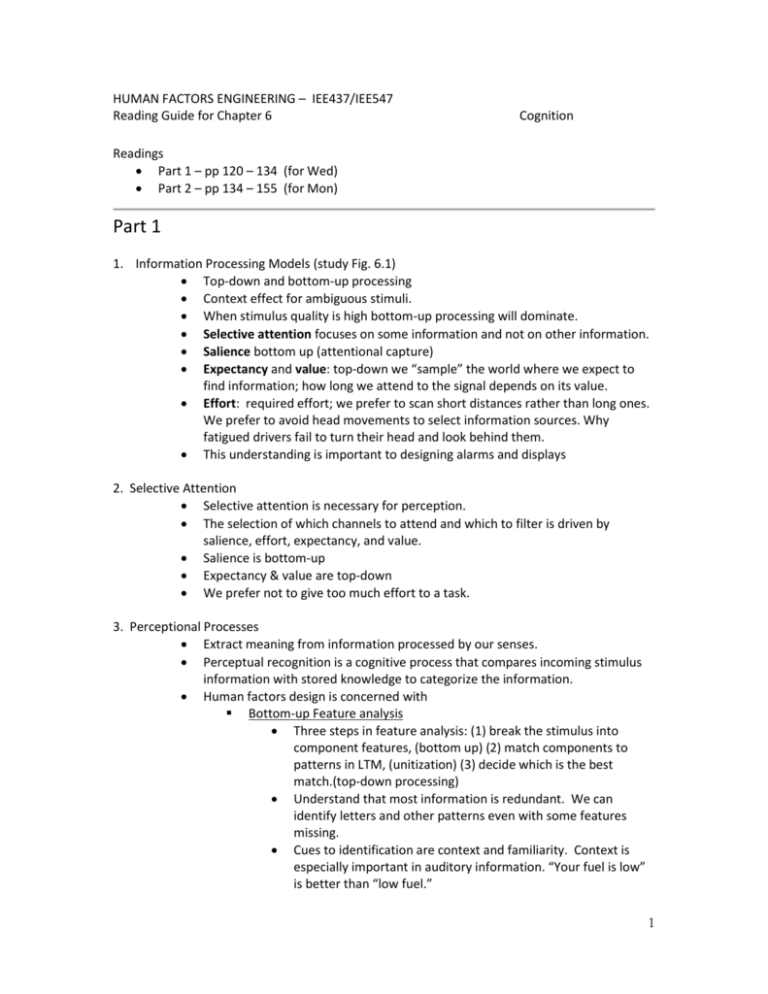
HUMAN FACTORS ENGINEERING – IEE437/IEE547 Reading Guide for Chapter 6 Cognition Readings Part 1 – pp 120 – 134 (for Wed) Part 2 – pp 134 – 155 (for Mon) Part 1 1. Information Processing Models (study Fig. 6.1) Top-down and bottom-up processing Context effect for ambiguous stimuli. When stimulus quality is high bottom-up processing will dominate. Selective attention focuses on some information and not on other information. Salience bottom up (attentional capture) Expectancy and value: top-down we “sample” the world where we expect to find information; how long we attend to the signal depends on its value. Effort: required effort; we prefer to scan short distances rather than long ones. We prefer to avoid head movements to select information sources. Why fatigued drivers fail to turn their head and look behind them. This understanding is important to designing alarms and displays 2. Selective Attention Selective attention is necessary for perception. The selection of which channels to attend and which to filter is driven by salience, effort, expectancy, and value. Salience is bottom-up Expectancy & value are top-down We prefer not to give too much effort to a task. 3. Perceptional Processes Extract meaning from information processed by our senses. Perceptual recognition is a cognitive process that compares incoming stimulus information with stored knowledge to categorize the information. Human factors design is concerned with Bottom-up Feature analysis Three steps in feature analysis: (1) break the stimulus into component features, (bottom up) (2) match components to patterns in LTM, (unitization) (3) decide which is the best match.(top-down processing) Understand that most information is redundant. We can identify letters and other patterns even with some features missing. Cues to identification are context and familiarity. Context is especially important in auditory information. “Your fuel is low” is better than “low fuel.” 1 Unitization – some things perceived as a unit (words or other things stored in LTM) rapid and automatic Top-down processing may be conceived as the ability to correctly guess what a stimulus or event is, even in the absence of clear physical features. High expectations are based on associations and context. (examples on p.125) Human Factors Guidelines in Perception – pp. 126 -127 Perception versus comprehension 5. Working (or short-term) memory (lasts about 7-70 seconds, it can be reactivated by rehearsal) We can maximize working memory by chunking information (Miller, 1956). Working memory can hold 7 +/- 2 chunks. A chunk is defined somewhat ambiguously as one bit of information. Three letters can be 3 chunks (RXF) or 1 chunk (CAN). If a combination of letters makes a pronounceable syllable, it will be more easily remembered than one that is not pronounceable. Provide spaces or grouping to create chunks. Working memory is limited in capacity and duration. Confusability and similarity Attention (the first step to remembering) can be diverted. Human Factors Implications of Working Memory Limits o Minimize working memory load o Provide visual echoes o Provide placeholders for sequential tasks o Exploit chunking Physical chunk size Meaningful sequences o Superiority of letter over numbers o Keeping numbers separate from letters (if you use letter and number, e.g. license plates, group the letters together and the numbers together) o Minimize confusability o Avoid unnecessary zeros (002385) o Ordering of text and instructions o Avoid negative. “Do” not “Don’t” Part 2 6. Long-term memory (lasts a life time, but accessing is sometimes a problem) Semantic - memory for concepts and meaning of words (general knowledge) May be semantic networks for different things. Transfer to long-term memory Learning is the process of storing information STM) in long-term memory. o Item strength (rehearsal) o Associations (meaningful connections) 2 Forgetting is a failure of memory retrieval often due to (1) weak strength due to low frequency or recency, (2) weak or few associations with other information, and (3) interfering associations. (recall vs. recognition) Remembering is enhanced by frequent rehearsal in working memory and in conjunction with other information related in a meaningful way. Thinking involves activation of the task-relevant material in working memory. 7. Organization of Information in LTM Schema is the entire knowledge structure about a particular topic (cups or vacations, college courses) Scripts typical sequence of activities like getting online or shutting down a piece of industrial equipment (also called procedural memory) Mental model is a dynamic schema. It is the understanding of how something works (ATM machine, telephone, computer, articles in the library) Cognitive maps mental representation of spatial information, like the layout of a city or a room. Mental rotation requires effort. Implications for maps. 8. LTM implications for Design Realize that the average user does not have a mental model and may fail to interactive with the system (programming a VCR) Encourage regular use of information to increase frequency and recency. Encourage active verbalization or reproduction of information that is to be recalled. Standardize Use memory aids (Knowledge in the World – Norman) Carefully design information to be remembered. Meaningful to the individual and semantically associated with other information. o Concrete rather than abstract words when possible o Distinctive concepts to reduce interference o Well-organized sets of information (groups) o Able to be guessed based on other information o Little technical jargon Design to support development of correct mental models. (“User should not have to read the manual”) 9. Episodic memory for events Episodic - memory for events in the past (think “episode”) Prospective – memory for things to do in the future 11. Episodic memory for events – bias can occur at any of 3 points Encoding (attention, expectancy) Storage (degraded memory, schema modification, biasing events) Retrieval (recognition, recall, keep false alarms & misses to a minimum) 12. Situation Awareness 3 Designers, researchers, and users often employ the cognitive concept of situation awareness to characterize users’ awareness of the meaning of dynamic changes in their environment. SA applies to a specific situation. Examples from the book of lack of SA: A pilot suffers a catastrophic controlled-flight into terrain. Control room operators at the Three Mile Island nuclear power plant lost SA when they believed the water level in the plant to be too high rather than too low. Three stages of situation awareness: Selective attention Understanding (short term and long term memory) Projection and prediction (mental models) Implications of SA to Human Factors Designing easy-to-interpret displays of dynamic systems. Tool for accident analysis Important for training (especially for attentional skills) 13. Attention and Time-sharing Time-sharing is the ability to perform more than one cognitive task by attending to both at once or by rapidly switching attention back and forth between them (divided attention). Four major factors determine the extent to which two or more tasks can be timeshared. o The degree to which one or more of the tasks are trained to automaticity. (Automatic processing does not require cognitive resources.) o The skill in resource allocation. o The degree of shared resources. o The degree to which task elements can become confused. 4
